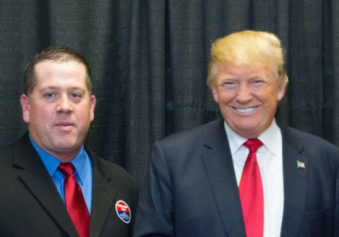The activist community in Washington, DC, is mourning the passing of Lawrence Guyot, a pivotal figure in the Civil Rights Movement in Mississippi who never became the household name of many of his civil rights compatriots.
After he moved to DC, Guyot was a tall, barrel-chested, ubiquitous presence in the capital city, fighting injustice and advocating for the poor at every opportunity. He died on Friday at age 73 after a long illness.
Guyot’s daughter Julie Guyot-Diangone said he had a history of heart problems and suffered from diabetes, and died at home in Mount Rainier, Md.
A Mississippi native, Guyot (pronounced GHEE-ott) worked for the Student Nonviolent Coordinating Committee and served as director of the 1964 Freedom Summer Project, bringing thousands of young people to the state to register blacks to vote despite a history of violence and intimidation by authorities. He also chaired the Mississippi Freedom Democratic Party, which sought to have blacks included among the state’s delegates to the 1964 Democratic National Convention.
“He was a civil rights field worker right up to the end,” Guyot-Diangone said.
Guyot participated in the 40th anniversary of the Freedom Summer Project to make sure a new generation could learn about the civil rights movement.
“There is nothing like having risked your life with people over something immensely important to you,” he told The Clarion-Ledger in 2004. “As Churchill said, there’s nothing more exhilarating than to have been shot at , and missed.”
His daughter told the Associated Press she recently saw him on a bus encouraging people to register to vote and asking about their political views. She said he was an early backer of gay marriage, noting that when he married a white woman, interracial marriage was illegal in some states. He met his wife Monica while they both worked for racial equality.
“He followed justice,” his daughter said. “He followed what was consistent with his values, not what was fashionable. He just pushed people along with him.”
Susan Glisson, executive director of the William Winter Institute for Racial Reconciliation at the University of Mississippi, called Guyot “a towering figure, a real warrior for freedom and justice.”
“I regard him as one of the real unsung heroes of the Civil Rights movement,” said Congresswoman Eleanor Holmes Norton, who had known her friend, community activist and lawyer for 50 years. “Most of those who were as badly beaten as him didn’t live to tell it much less live a life of struggle. He was much respected for carrying on many different struggles in this town. He didn’t confine himself. He knew injustice when he saw it because he had seen it at its worst.”
Norton, 75, told the Washington Informer that she first met Guyot when he was imprisoned with famed Civil Rights Campaigner Fannie Lou Hamer and 14-year-old June Johnson in Winona, Miss., for registering black people to vote. In Mississippi at the time, intimidation, violence and even murder were used to ensure that blacks would not try to vote.
“I first met him when I was a law student in Mississippi, went to Greenwood, Miss., and was told that he’d been put in jail in Winona. I went there to try to get him out of jail,” Norton recalled. “They let him out of jail to allow him to be beaten by the White Citizens’ Councils. When you meet someone under those circumstances, you form a lasting bond. At that time there was almost no Civil Rights movement in Mississippi. It had spread throughout the South and the last place to go was Mississippi.”
“There was terrorist violence for anyone who threatened the regime – from the courts to the police to all parts of the community.”
According to Chuck Thies, a local DC political consultant, political analyst and commentator, Guyot was a unique man and activist.
“He is an irreplaceable force in the District. I am saddened by his death,” said Thies, 47. “He was a civil rights warrior who used his background in D.C. politics. Lawrence was different from the civil rights leaders of that era who are still around today. He was jailed and beaten and risked his life for the cause of civil rights. Don’t get me wrong, people like Eleanor Holmes Norton, Marion Barry and Ivanhoe Donaldson were courageous, but Lawrence did not use his civil rights background as a way for upward mobility.”
Thies broke down some of the important work Guyot did in DC.
“In 2003, he worked with whites to have the District as the first Democratic primary in the 2004 presidential race. He legitimized the effort in the D.C. civil rights and black community. In 2004, at a discussion of a Ken Burns film, he said that D.C. is racially divided and the only thing that is bringing the people of the city together is Howard Dean and Kwame Brown. That is a classic Guyotism.”
Longtime civil rights activist Dorie Ann Ladner said she talked to Guyot every day to discuss politics locally and nationwide.
“It really will be hard to not have those discussions. He was a fearless warrior in civil rights, housing, jobs, and justice,” said Ladner, who met Guyot as a teenager in 1961. “He was a political animal. I’d call him every day and ask what was on the agenda.”
Ladner said her friend was “always there advocating for the poor and downtrodden.”
“He supported group homes in D.C. neighborhoods when a lot of people were opposed to them,” said Ladner, 70. “We fell out when he supported [former Mayor Adrian] Fenty. I chased him across Turkey Thicket. He got up and started trotting and I was on a crutch after him. I told [Kwame] Brown I was looking for him.”
“And when he supported Carol Schwartz, I got up and gave him a piece of my mind and after that, I gave him a ride home. Our core beliefs were the same. That is where we were joined at the hip. You couldn’t separate us.”
Ladner said Guyot paid a painful price for his fight for freedom and equality.
“He was in Parchment Prison at least two times that I know of,” she said. “In Greenwood, he looked like one of the Somali refugees. He’d lost 100 pounds and had his head shaved. They turned on the heat at night, tortured them. Once, they had to jump out of a window in Greenwood. I often joked with him about how he got out the window because he was always robust, but he said ‘you gotta do what you gotta do…’”


